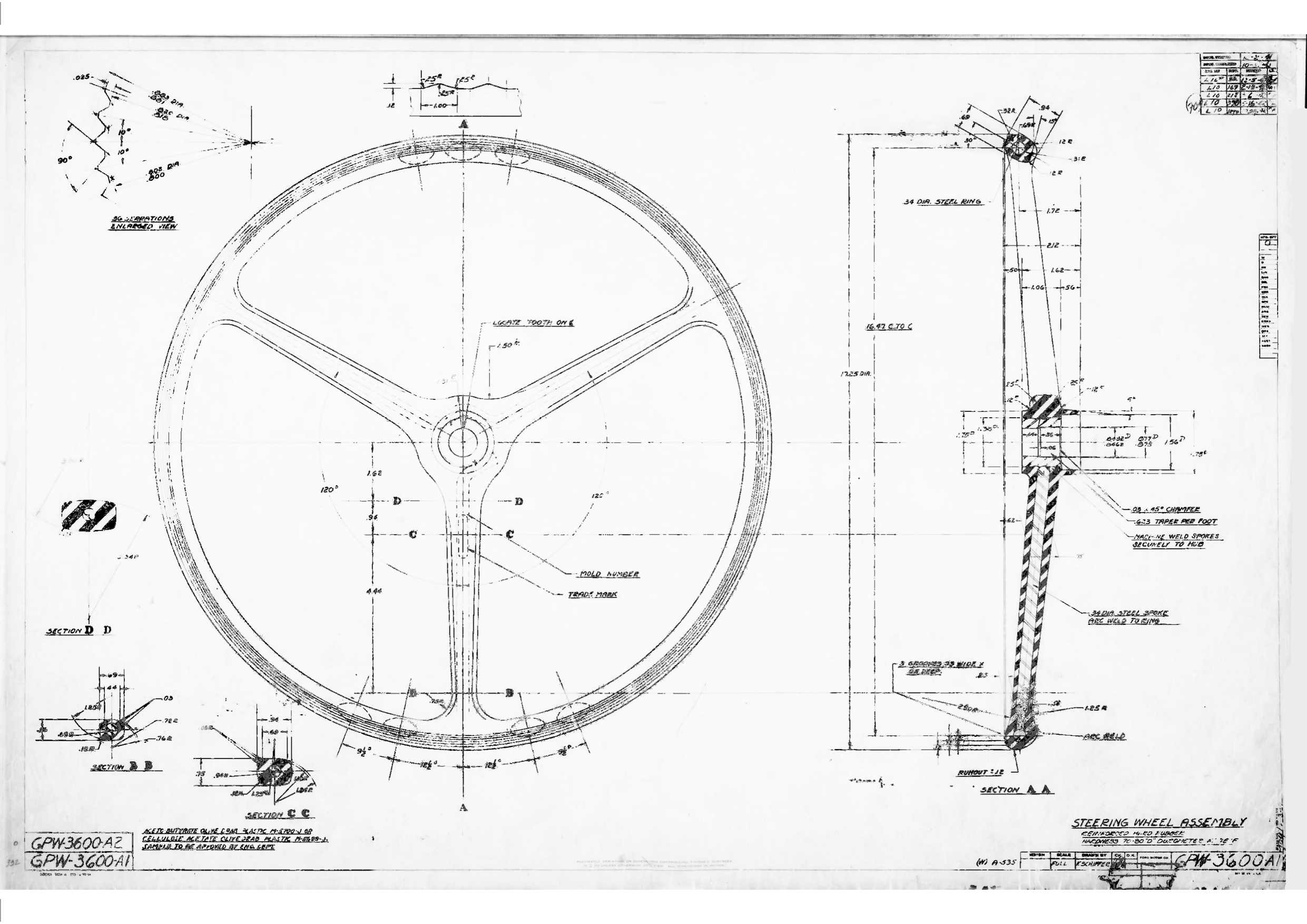Sheller
MB/GPW Sheller Steering Wheels
I have recently been fortunate enough to obtain both a black Tenite NOS 5 Sheller wheel from William in Belgium and a black Thermoset NOS 9 Sheller from Alfredo in the Phillipines.
I attach here a few pictures of these two wheels. The acetate plastic Tenite 5 Sheller is on the left. The hardrubber/bakelite/thermoset 9 Sheller wheel is on the right.
Here is what I found comparing these two wheels
Wheel on the left:
– Marked 5 Sheller on back, kerning very close and little space left on ends of word Sheller.
– Hot pin goes in easy, so it seems to be some sort of acetate plastic (Tenite)
– Weighs about 4.1 lbs
– Has six 1/8 in tooling holes on back side
– Has grooves
– Short hub (some wheels I have seen have ½ in longer hub)
– Exactly the same pattern and dimensions as many supposedly WWII green 5 Shellers I have seen. (including 1/8 in holes rather than 5/16 in plugs)
Wheel on the right:
– Marked 9 Sheller on back, kerning wider and has some space at ends of word Sheller.
– Hot pin does not go in at all, smells of sulfur (suggesting hard rubber or some sort of Thermoset material)
– Weights 4.6 lbs
– Has no holes on back, no trace of plugs on back
– Has grooves
– Short hub
– Exactly the same pattern and dimensions as many supposedly WWII green 5 Shellers I have seen, except no tooling holes or plugs.
– Has several micro cracks, seems very brittle
The 9 Sheller wheel (Thermoset) was noticeably heavier… and the surface is much more shiny than the 5 Sheller.
Here are the pictures:
As I got the 9 Sheller wheel (note that it has a typical WWII style packing tape on one spoke (no numbers however), it was clearly 40’s style adhesive…)
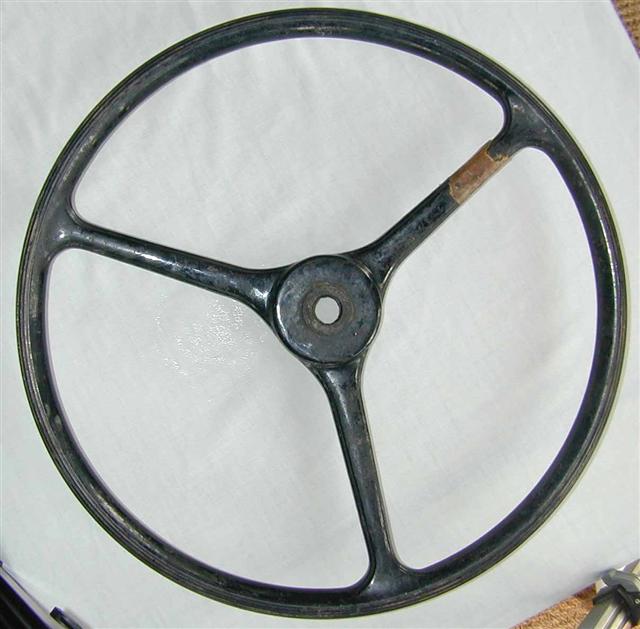
Back NOS 5 Sheller (Tenite) on left, NOS 9 Sheller (Thermoset) on right:
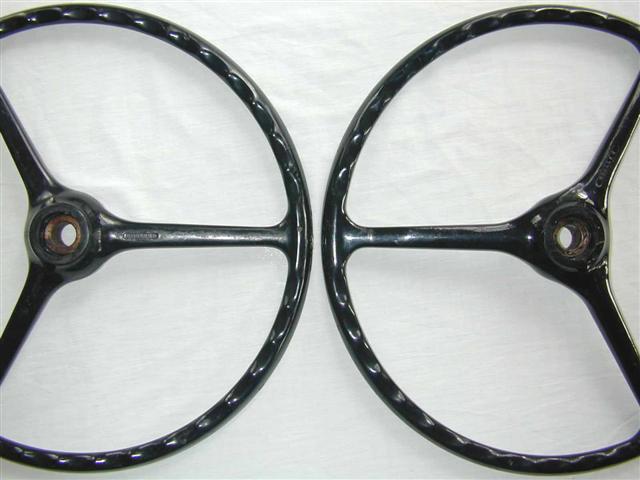
Grooves of NOS 9 Sheller (Thermoset) (Notice the micro-crack, and this is an NOS wheel!):
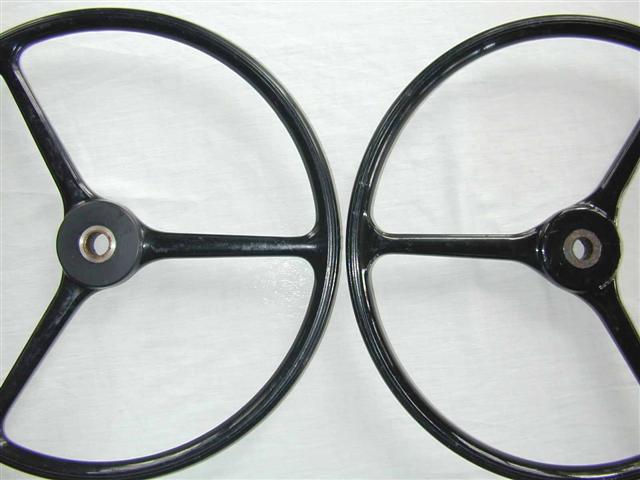
What I would like to find out is, has anyone ever seen a Black Sheller with 5/16 in plugs?. I belive that there may have been a change from black Thermoset to balck Tenite at some point in late 41 or ealry 42 becasue of the fragile nature of the Thermoset wheel, and the key would be the 5/16 plugs. Later green wheels look to have had 1/8 in holes, once sombody figured out that they could simplify the tooling using a twist off sort of support in the mold instead of chairs, such as this 5 Sheller with 1/8 in holes.
Here is an example of an early green Sheller with the large 5/16 in holes (originally plugged):
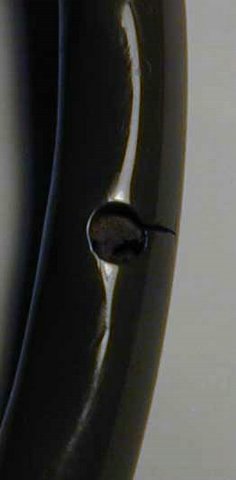
Here is an example of a green Sheller with small (1/8 in) holes on the back:

Or, to make a long story short, here is what I belive:
1941 – Black Thermoset, no holes on back
Early 1942 – Possible use of black Tenite wheel with 5/16 plugs on back
March 1942 – Change to green Tenite with 5/16 plugs on back
Late 1942 – Possible change to green Tenite with 1/8 in holes on back
Early 1943 – Change to green metal spoke wheel
1946 – CJ2As with black Tenite with 1/8 in holes on back
All these wheels (except the common metal spoke wheel) have almost the same patterns and dimensions. They all have grooves. I have not yet seen any proof that any wheels did not have grooves. Wheels without gooves are just worn down.
I belive the number on the left is a mold number, not much to do with style… Used to track what mold was used for this particular wheel.
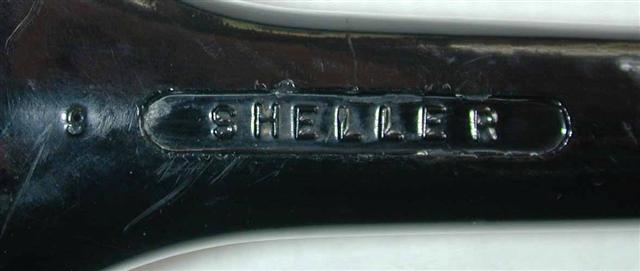
I belive this is an original Sheller wheel. When you force a hot pin into the back of the hub, you smell lots of sulfur. This means the wheel is made of hard rubber, and most likely produced before the introduction of Tenite wheels, in the middle of 1942.
I made measurements of the three wheels in the attached picture. These included my NOS black Tenite Sheller that has “ribs”, and two used green Tenite Shellers that have traces of “ribs”, but are quite smooth. The numbers support the hypothesis that Shellers that are smooth now, probably have had “ribs” in the past. One of the green Shellers is from a Dec 42 MB that is known to have been surplused in 1946, and so it is unlikely that it would have gotten a green wheel after that time.
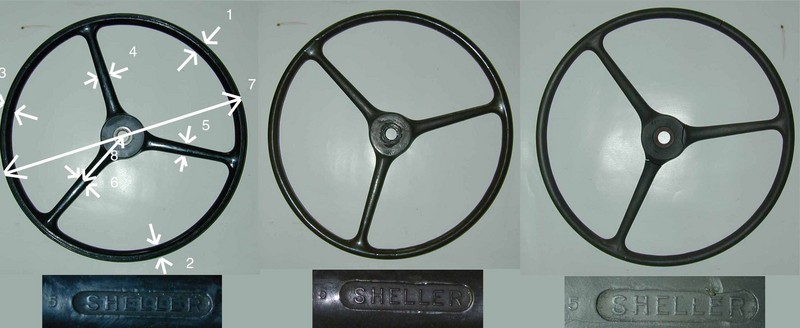
Here are the numbers per the above:
Ref NOS Green1 Green2
1 – rim 0.8 0.736 0.72
2 – rim 0.8 0.722 0.706
3 – rim 0.8 0.747 0.72
4 – spoke 0.83 0.805 0.775
5 – spoke 0.85 0.786 0.791
6 – spoke 0.85 0.8 0.8
7 – dia 17.18 17.09 17.06
8 4 4 4
Note that the spokes are all very close in size, but the rims of the two used green wheels are quite a bit smaller than the NOS black one.
Here is the July 1942 Life Mag picture of a green Sheller. From looking at other pictures of this MB in the article, it is clear that it was probably produced in April or May, and not later than June 1942.
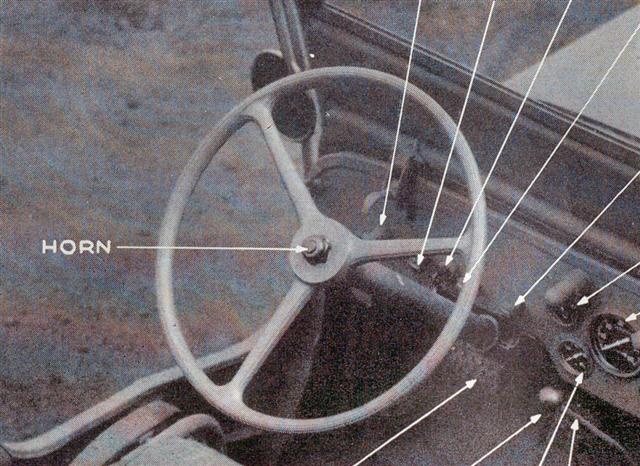
So… I don’t yet know what this means, but along with the July 1942 Life Magazine picture that clearly shows “ribs”, it strongly suggests that many (if not all?) green Shellers had “ribs”. At least the ones that came from the No. 5 mold…. and that because the Tenite plastic wears down, these “ribs” dissapear, so some people swear that they never had ribs….
1. Does anyone have a green Tenite Sheller wheel with a rim width of at least 0.8 inches that does not have “ribs”?
2. Does anyone have a black Tenite Sheller that they think is WWII?
The wheel that has been used as the pattern for the repro wheels I have seen has a hub 1/2 in longer than most of the supposedly WWII Shellers I have seen, and if you look closely, you will see marks on the repros where there seems to have been a 5/16 in plug in the original pattern… hmmm. This could blow my theroy… more field data needed on the 2 inch hubs…
Please, would everyone with a black Sheller having a 1 and 1/2 inch thick hub, check for 5/16 plugs (or holes) or traces of them?
Update Nov 2018:
Recently the The Henry Ford Museum has put up some GPW drawings, one of which is the Sheller steering wheel. They confirm a number of my observations above. Note that on the bottom right above the drawing title block it seems to say that the “A1” variant is made of “hard rubber”, while on the left lower corner, next to the “A2” variant they talk about olive drab cellulose acetate butyrate or cellulose acetate (These are probably “Tenite”) . The drawing change block in the upper right is smudged, but if I had to guess, looks to me like the drawing change from hard rubber to cellulose acetate (i.e. A1 to A2) occurred on either 5-6-42 or 5-16-42. I am guessing that this proves that there never was a black “Tenite” version used during the war. Any black cellulose acetate wheels are post-war, and all early black wheels were hard rubber (i.e. with sulfur).
